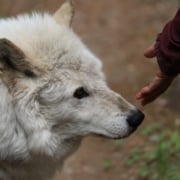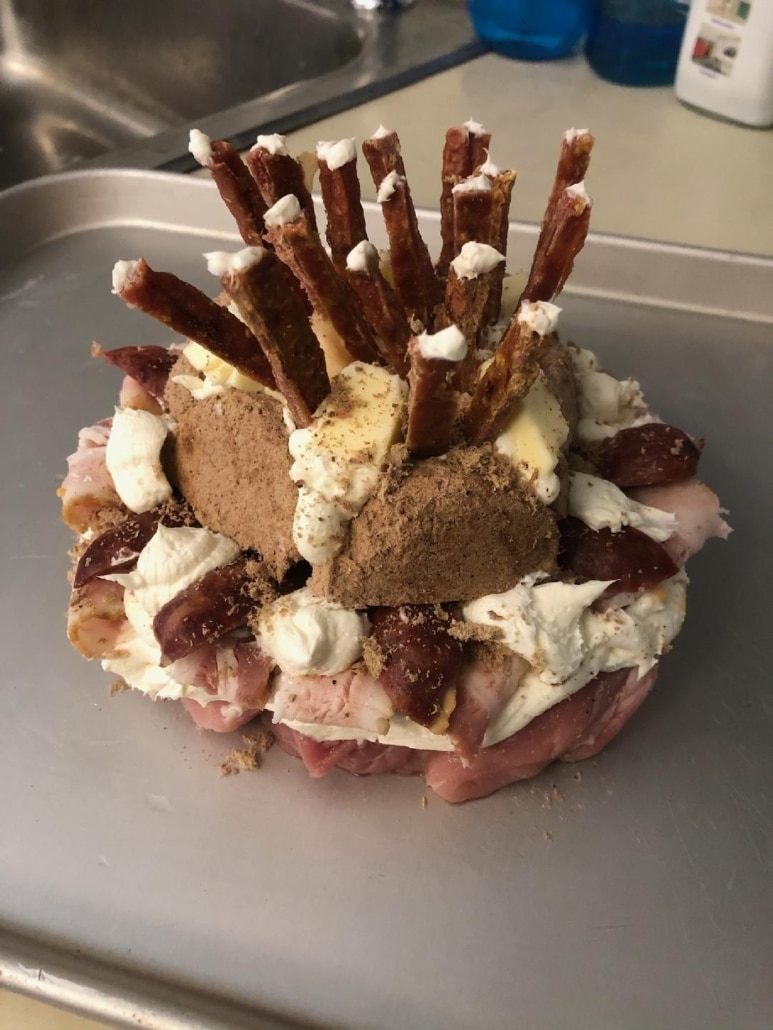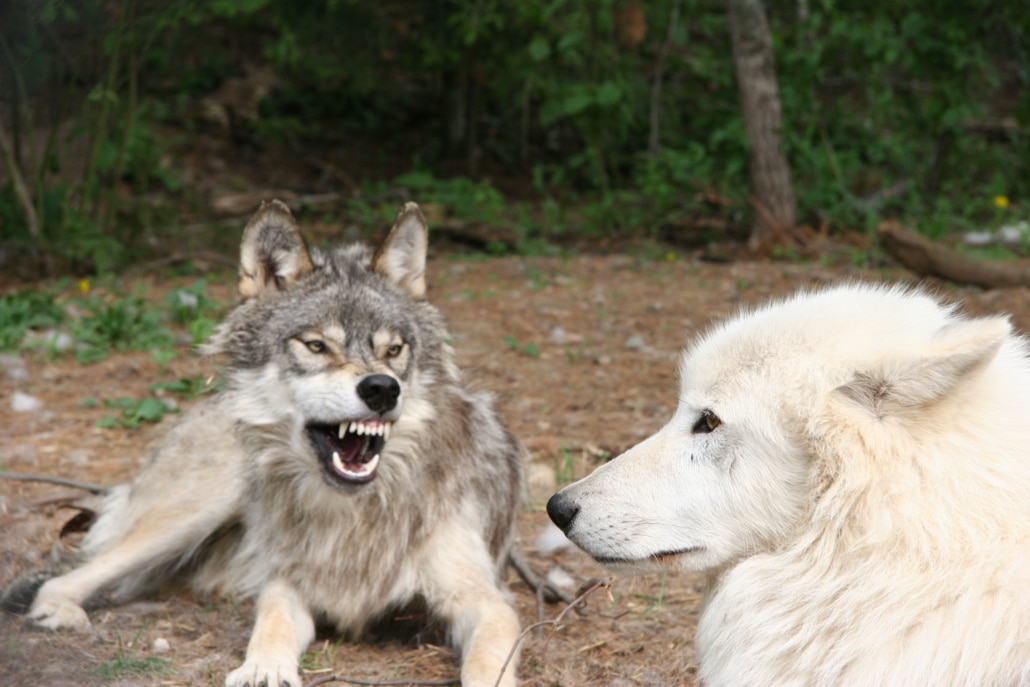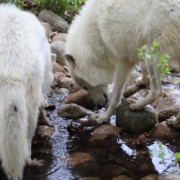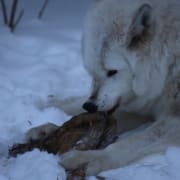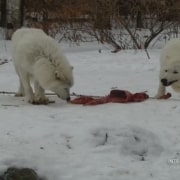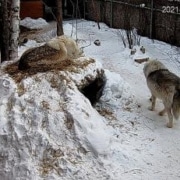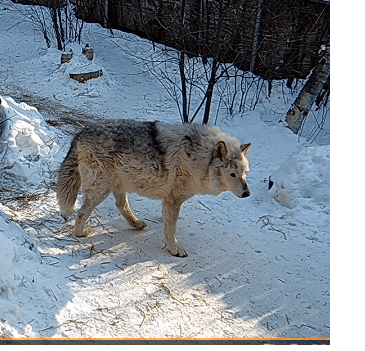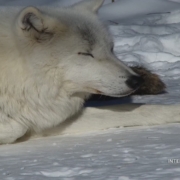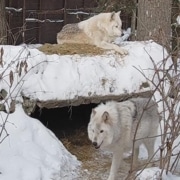The next 3 days will be extreme with record high temperatures and the potential for high humidity. These conditions will be concerning for all of our wolves, but especially the retired wolves. This is more problematic than a hot July day since the wolves are still in the middle of their shedding process. Staff are diligently brushing the wolves on a daily basis to remove this heavy undercoat. We are fortunate to have many shaded spaces, cool layers of sand, trees that shade and cool through their transportation, misting systems and ponds for taking a dip. Even Grizzer likes to wade into the pond to get some relief from the heat. Staff will be diligent over the weekend to make sure there are not signs of animal health issues with the heat.
Archives
Twenty days ago, we celebrated a milestone. Grizzer turned 17 years of age on May 5th, 2021. We shared his birthday with some of his favorite staff; Wolf Specialist Abby Keller made him a birthday cake that he enjoyed (well, Denali helped). We see Grizzer slowing down, but not losing his personality or spunk. Due to some advancing cataracts, he relies heavily on his sense of smell. A decline in vision has not impacted his awareness. He manages to identify our Veterinarian from a distance, usually with a warning bark-howl. To try and reduce some of his tension about a vet visit as well as some of the chainsaw work done by the Vermilion student work crews, we are trying to integrate our Vet and VCC instructor, Ryan Miller into the wolf care team. So far, Grizzer has been the biggest challenge, posturing and testing just like he did when he was a yearling, although a bit slower. We use techniques to help the process including using positive associations. With the new person’s smell (maybe from a t-shirt or flat hand at the fence) along with a treat, we try to gain acceptance. So far, what we have gained is an appreciate that regardless the age, a wolf’s personality seems to live on. Grizzer was a bold, testing yearling and he’s a bold testing 17 year old. Denali’s response has been quite different. Denali’s has displayed more playbows and social instigation, indicative of his history as a pack member that was most concerned with the food being delivered rather than the staff that made the delivery. In this week’s photo, Grizzer uses his sense of smell to determine the staff interactions and the photos below show his birthday cake and the attitude of a yearling wolf, posturing and testing the dominant wolf, Shadow.
So sorry for the extended delay in posting; Since our last post, we have transitioned out of winter and right past spring into some hot, humid weather. By the seasonal calendar, May is still considered spring, but with temperatures in the 80 degree range, the wolves can have challenges keeping cool. We are fortunate to have a pond and a pump system that circulates water through a UV filter system to help keep the pond relatively algae free during the heat. In this week’s image, Axel and Grayson investigate the flow of the upper pond. This photo clearly shows the oversized foot per leg ratio that is classic wolf.
We survived the Polar Vortex, most importantly, Grizzer at the age of nearly 17, survived the Polar Vortex with rural Ely breaking a record of -50.2 below zero. We were a bit warmer up on the hill at the Center with -37 being our coldest. The use of the Wolf Care Center, a 70 degree building for morning feedings and extra food resources made the days more tolerable. Now that the weather is moderating, we are able to feed more carcasses that will stay thawed for more than an hour when sitting in the snowbanks of the enclosure. Grizzer can easily defend his food from Denali, but if not, staff have back up dinners prepared.
Each week, I try to pick one of the many photos on the Explore.org Gallery pages. This week I have selected an image from Tina Warne. The photo shows Axel on the right with a slight food defensive face towards Grayson on the left. While it often appears that Grayson has to wait for dinner, we do monitor scats and see that he gets his fair share of food (even if it has to be a post feeding chicken breakfast). On Thursday night, staff fed 2 beaver to the Exhibit Pack. The Vermilion Community College Wolf Ethology class was on site learning the data collection techniques and software to begin their spring assessment of the dynamics between Axel and Grayson. This is a trial period for a new data collection app that we hope to adopt for the pup introduction. We will post data results from the students research during their final exam period in May.
While Grizzer and Denali are different subspecies, their full winter pelage can make it hard to tell them apart.
Denali has more fire-brown tones on the back, Grizzer is more grey and has a well marked black stripe in the middle of the back between the light of the neckline and the grey of the lower back.
For each log, I try to select a photo from the Explore.org Gallery that represents the weekly behavior of the Exhibit Pack. Thanks to “jdy4wildlife” for posting this image of Grayson resting near his deer carcass. Notice the outstretched paw that signals to the scavengers that he still has possession even though he is trying to nap. This past week has been our first real blast of winter weather, with a polar vortex delivering some 25-30 below zero air temperatures. Wolf Specialist Abby Keller provided some good details on wolf adaptations to cold climates.
Our wolves are all subspecies that are equipped to handle subzero temps in the wild! Gray wolves have an insulating undercoat with guard hairs to keep them warm in extreme temps. In the winter, they also develop a thick layer of body fat to keep them insulated. The paws of gray wolves are covered with fur that insulates their paw pads and increases traction on slippery surfaces. Their paws are also a kept at a lower temperature than their core body heat, minimizing the amount of heat loss in extremities. Blood that flows into the paws naturally heats up the blood returning to the heart; this phenomenon is referred to as countercurrent heat exchange. This saves metabolic energy and prevents the core from cooling down due to heat loss at the extremities. This mechanism is also found in penguins!
That being said, we do our best to offer as much comfort to them as possible. All of our wolves have 24/7 access to enclosed areas that block the wind and keep out snow. They also have several dens that the can use to rest in if they so choose. We provide multiple beds of hay for them to rest on off of the cold ground, as well as increased meals to keep their metabolism up, thus increasing their core body temp.
Denali and Grizzer are having a great winter, not just the weather (which has been warmer than average), but they spend a lot of time in playbows, tail wags and traveling throughout the three retirement enclosures. Grizzer’s hearing is nearly gone and his cataracts definitely make it a challenge for him to see anything dropped on the ground, but his sense of smell is as strong as ever. This weekend a “Polar Vortex” is expected to drop temperatures to near 40 below zero. We increased the amount of hay in both enclosures and the Retired Wolves have many warm resting spots as well as the option to come inside the Wolf Care Center if needed.
This photo was captured from the Center’s Back Habitat webcam den and was posted on the Explore.org site by Elena-Italia
With the Center being closed throughout the early winter due to COVID restrictions, Axel and Grayson seemed very interested in the return of visitors to the Center by late January. They positioned themselves at the windows, watching the activity as visitors made some face-to-face connections, especially those exuberant younger visitors. As the Center went back to the “What’s for Dinner” program, we switched from smaller, more frequent feedings to the larger deer torso feedings. This created some interesting rank-order behaviors between Axel and Grayson who have been posturing for some rank since Denali retired. Grayson seems to be increasing his confidence without Denali’s intimidating presence. With Grayson’s tendency for bonding, we are very interested to see how he interacts with the pups next summer.
With temperatures reaching an overnight low of -27 degrees, we added a few extra food resources in addition to the Retired Wolves morning breakfast of 3-4 pounds of meat. In this image, Grizzer manages to keep a deer leg from Denali and proudly carries it through the pack holding area. While we have plenty of thick straw beds and covered spaces for the wolves to curl up on a cold winter night, there is an advantage to keeping them active with good circulation to their extremities. The extra food resources encourage activity, competition and extra calories as well as keeping Grizzer’s mind alert.

The International Wolf Center uses science-based education to teach and inspire the world about wolves, their ecology, and the wolf-human relationship.


